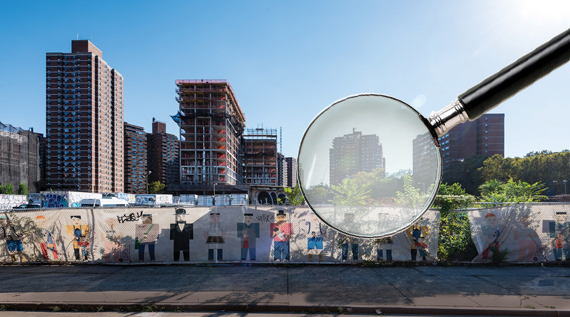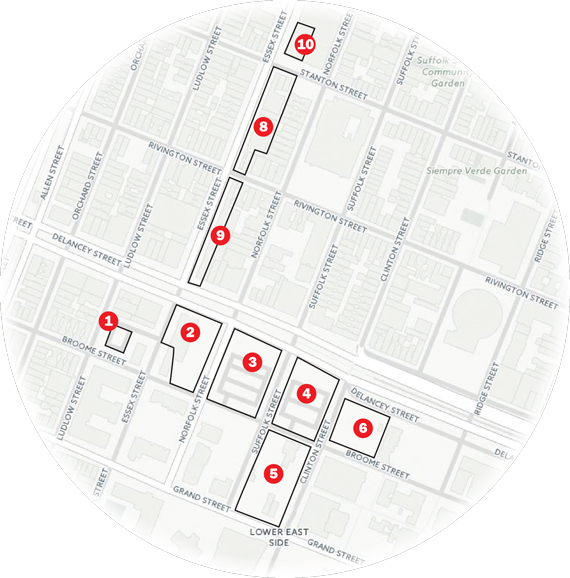Trending
The making of a Lower East Side linchpin
As Essex Crossing takes shape, </br>TRD dissects the $1.5 billion </br>mega-development

For five decades, Broome Street east of Essex was a dead zone — blighted by the remnants of a slum clearance and urban renewal project whose renewal never materialized, stymied by political squabbling. These days, however, pedestrians avoid that stretch of Broome for a different reason — it’s a massive construction site. Three years after the city selected a consortium of developers to put the six long-vacant acres to use, four of the nine buildings that comprise the $1.5 billion Essex Crossing mega-development are in progress, with an additional two expected to break ground in 2017.
Delancey Street Associates, which represents a joint venture of L+M Development Partners, BFC Partners, and Taconic Investment Partners, and Goldman Sachs, which holds the majority equity stake, is on track to build 1,000 units of housing, half of them affordable, as well as 250,000 square feet of office space, a public park and retail, including an expanded Essex Street Market, a Trader Joe’s grocery store, a bowling alley and a movie theater. An affordable rental building for seniors, and another rental with both affordable and market-rate units, have both topped out.
In a neighborhood where most of the buildings are 100 years old, the fact that the developers have the opportunity to build “an entire community from scratch [is] exciting and unprecedented,” said Deborah Gutoff, senior director and principal at Eastern Consolidated. “It’s almost like a city within a city.”
 Although the project’s third and final phase isn’t scheduled for completion until 2024, the development’s retail component, dubbed the Market Line, is expected to open in 2019. The bi-level shopping arena will span three blocks and house the revamped Essex Street Market, as well as 150 densely packed vendors aimed at representing the Lower East Side’s diverse immigrant food heritage, according to Rohan Mehra, principal at the the Prusik Group, which is handling the retail component.
Although the project’s third and final phase isn’t scheduled for completion until 2024, the development’s retail component, dubbed the Market Line, is expected to open in 2019. The bi-level shopping arena will span three blocks and house the revamped Essex Street Market, as well as 150 densely packed vendors aimed at representing the Lower East Side’s diverse immigrant food heritage, according to Rohan Mehra, principal at the the Prusik Group, which is handling the retail component.
Brokers and neighboring developers said they expect the project to exert a gravitational pull. Arthur Stern, partner at Cogswell-Lee Development, which is developing 150 Rivington Street, a 45-unit condo building, said redeveloping the long-dormant parcels will bring “more everything to the area, thousands of residents, thousands of shoppers and a vitality to a part of the city that didn’t have it previously.”
Units at 50 Clinton Street, a condo being developed by DHA Capital two blocks north of the Essex Crossing site, are averaging $2,200 a foot, according to managing principal Daniel Hollander. “Which was unthinkable even three years ago,” Hollander said. “It shows people are willing to pay pretty significant dollars to live in that area.”
Of course, the Lower East Side has hardly been languishing all these years — the neighborhood is home to art galleries, bars and music venues. Nor is it a stranger to luxury development. Blue, a Bernard Tschumi-designed condo on Norfolk Street, opened in 2007.
“The neighborhood is fundamentally appealing, with nice little buildings and nice little streets, so [redevelopment] would have happened anyway,” said Nat Rockett, an investment sales broker at Marcus & Millichap. “This will accelerate the timeline.”
But the changes have not been welcomed by the all the neighborhood’s denizens, particularly those whose attachment to the area is more economic than aesthetic.
Tensions between poorer long-time residents and wealthier newcomers are “a natural fear,” Stern acknowledged. “But the character of the Lower East Side will remain constant because of the nature of the buildings and the blocks.”
For their part, the developers of Essex Crossing have stressed that the project will not only make good on a decades-old city promise to build housing for low- and middle-income New Yorkers on land that 2,000 people were displaced from in the 1960s, but also add much-need amenities to the neighborhood.
To be sure, not all the puzzle pieces are in place. A tenant is still being sought for the project’s “cultural space” after the Pittsburgh-based Andy Warhol Museum backed out in 2015.
The ideal cultural tenant would be someone with both vision and financial resources to contribute to the cultural fabric of the Lower East Side, according to Isaac Henderson, a director at L+M Development. “Our goal is to make Essex Crossing a destination for a variety of different people,” he said.
It’s also yet to be seen whether the redevelopment of the sites south of Delancey Street that were used as parking lots will repair the divide between the northern and southern sections of the neighborhood, currently bisected by the multi-lane thoroughfare.
However, Hollander speculated that more development will venture south of Delancey, the longtime “demarcation line” of desirability.
Ultimately, most view the project as a win-win, redeveloping parcels that have contributed little to the neighborhood over the decades.
“It’s replacing a bunch of parking lots and retail that never added any value, like dollar stores,” said Jordan Sachs, chief executive of residential brokerage Bold New York.
“These are things that every income level will use,” he said, adding, “Who doesn’t want a Trader Joe’s?”





